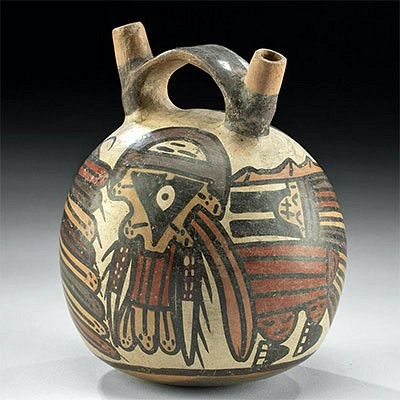19th C. Gilt Russian Icon - Our Lady of Unexpected Joy
Lot 136
About Seller
Artemis Fine Arts
686 S Taylor Ave, Ste 106
Louisville, CO 80027
United States
Selling antiquities, ancient and ethnographic art online since 1993, Artemis Gallery specializes in Classical Antiquities (Egyptian, Greek, Roman, Near Eastern), Asian, Pre-Columbian, African / Tribal / Oceanographic art. Our extensive inventory includes pottery, stone, metal, wood, glass and textil...Read more
Categories
Estimate:
$600 - $900
Absentee vs Live bid
Two ways to bid:
- Leave a max absentee bid and the platform will bid on your behalf up to your maximum bid during the live auction.
- Bid live during the auction and your bids will be submitted real-time to the auctioneer.
Bid Increments
| Price | Bid Increment |
|---|---|
| $0 | $25 |
| $300 | $50 |
| $1,000 | $100 |
| $2,000 | $250 |
| $5,000 | $500 |
| $10,000 | $1,000 |
| $20,000 | $2,500 |
| $50,000 | $5,000 |
| $100,000 | $10,000 |
| $200,000 | $20,000 |
About Auction
By Artemis Fine Arts
Feb 10, 2022
Set Reminder
2022-02-10 10:00:00
2022-02-10 10:00:00
America/New_York
Bidsquare
Bidsquare : Ancient & Ethnographic Art Through The Ages
https://www.bidsquare.com/auctions/artemis-gallery/ancient-ethnographic-art-through-the-ages-8873
Join us for Part Two of a spotlight on two fabulous collections, one from Lumberton, Texas, and the other from Whisnant Gallery in New Orleans. Artemis Fine Arts info@artemisfinearts.com
Join us for Part Two of a spotlight on two fabulous collections, one from Lumberton, Texas, and the other from Whisnant Gallery in New Orleans. Artemis Fine Arts info@artemisfinearts.com
- Lot Description
Eastern Europe, Russia, ca. 19th century CE. Finely painted in gold, egg tempera, and gesso on wood, this icon depicts a scene called "Our Lady of Unexpected Joy," in which a sinner kneels before an image of the Virgin Mary holding the infant Christ. While pondering a malevolent action, the image of the Mother of God was brought to life, and the hands of Jesus began to bleed. The sinner, upon inquiring about why the infant's hands bled, was given 2 explanations by the Virgin Mother: that sinners like himself acting upon their evil ways caused her son's repeated crucifixion; and that the joy of Heaven was far greater for one repentant sinner than for that of 99 virtuous individuals. Not only did these answers absolve him of his past misdeeds, but the sudden bliss overtook him with emotion and a personal vow of piety. Size: 10.3" W x 12.3" H (26.2 cm x 31.2 cm)
According to the Orthodox Church of America website, "The sinful youth, who was nevertheless devoted to the Theotokos, was praying one day before the icon of the All-Pure Virgin before going out to commit a sin. Suddenly, he saw that wounds appeared on the Lord's hands, feet, and side, and blood flowed from them. In horror he exclaimed, 'O Lady, who has done this?' The Mother of God replied, 'You and other sinners, because of your sins, crucify My Son anew.' Only then did he realize how great was the depth of his sinfulness. For a long time he prayed with tears to the All-Pure Mother of God and the Savior for mercy. Finally, he received the unexpected joy of the forgiveness of his sins." The "Unexpected Joy" icon is commemorated on January 25 and May 1.
This icon most likely was kept in someone's home. According to Jeanne Marie Warzeski, scholar and curator of the North Carolina Museum of History's "Windows into Heaven" exhibition, "In the early Byzantine Empire, the home became the primary base for the development of icon veneration. Throughout the ensuing centuries, icons continued to receive honor in homes and churches. To this day, many Orthodox Christians create for prayer and meditation in their home a krasny ugol, or "beautiful corner," where family icons are placed. Guests entering a house customarily honor the icons in the corner by crossing themselves before the objects. An oil lamp is set near the icons and is lit daily, according to Orthodox tradition."
Icons (icon means "image" in Greek) are sacred objects within the Eastern Orthodox Christian tradition. Found in homes as well as churches, these painted images depict holy persons and saints as well as illustrate scenes from the Scriptures. Icons are not worshipped, but are instead venerated for their ability to focus the power of an individual's prayer to God. As a focus for prayers and meditation for believers, icons serve as "windows into heaven."
Provenance: private New Jersey, USA collection
All items legal to buy/sell under U.S. Statute covering cultural patrimony Code 2600, CHAPTER 14, and are guaranteed to be as described or your money back.
A Certificate of Authenticity will accompany all winning bids.
PLEASE NOTE: Due to recent increases of shipments being seized by Australian & German customs (even for items with pre-UNESCO provenance), we will no longer ship most antiquities and ancient Chinese art to Australia & Germany. For categories of items that are acceptable to ship to Australia or Germany, please contact us directly or work with your local customs brokerage firm.
Display stands not described as included/custom in the item description are for photography purposes only and will not be included with the item upon shipping.
#169037Vertical break line down center with some restoration and repainting. Losses to gesso and tempera near break line, on peripheries, and in upper right corner. Some expected nicks, chips, abrasions, and scratches throughout. Otherwise, very nice with great pigments. Back slats visible on verso.Condition
- Shipping Info
-
All shipping is handled in-house for your convenience. Your invoice from Artemis Gallery will include shipping calculation instructions. If in doubt, please inquire BEFORE bidding for estimated shipping costs for individual items.
-
- Buyer's Premium



 EUR
EUR CAD
CAD AUD
AUD GBP
GBP MXN
MXN HKD
HKD CNY
CNY MYR
MYR SEK
SEK SGD
SGD CHF
CHF THB
THB













